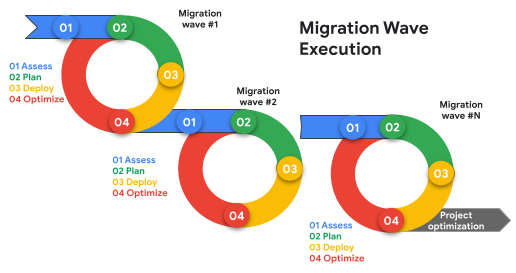规划迁移后,您可以继续执行迁移。本文档和以下文档综合介绍了可用于执行迁移的方法和工具。
准备工作
初始迁移准备工作
云迁移项目是推动将工作负载迁移到 Google Cloud的组织性重大举措。
每个迁移项目都分为多个波段。波浪是指具有共同特征或相互依赖关系的一组应用,由工作负载发现和评估功能确定。由于外部依赖项较少,独立应用和数据库通常是第一波迁移的理想候选对象。另一方面,具有显著相互依赖关系的工作负载会构成复杂的迁移波,需要进行额外的规划。在这种情况下,您需要优化迁移计划,以审核相互依赖关系对业务的影响,并移除可能阻止迁移的障碍。
迁移波次中的工作负载会被划分为迁移组,并在Sprint 中迁移到 Google Cloud 。迁移组是一组您需要一起迁移的基础架构资源和工作负载,这些资源和工作负载可以属于同一应用,也可以属于一组相互依赖的应用。
在每个冲刺期间,您需要执行以下操作:
- 准备并集成迁移所需的工具。
- 制定冲刺计划。
- 执行冲刺计划。
迁移过程和方法
冲刺计划和手册
在 Sprint 计划中,定义您将如何执行分类为 Sprint 的迁移波次。通过解决以下构建块来创建手册。
| 人数 | 资源项 | 说明 |
|---|---|---|
| 0 | 迁移工具架构 | 构成迁移工厂的工具的架构(用于持续评估、波次计划优化、特定于工作负载的迁移、构建、测试、部署和监控的工具) |
| 1 | 迁移核对清单 | 迁移冲刺之前和期间的核对清单 |
| 2 | 资产清单 | 将迁移到 Google Cloud的工作负载列表 |
| 3 | Sprint Runbook | 迁移每项工作负载的执行准则 |
| 4 | 迁移计划 | 迁移 Sprint 期间要遵循的分步迁移计划(流程) |
| 5 | 网络和安全规则 | 列出在迁移到 Google Cloud期间对 Google Cloud DNS 更改的所有入站和出站防火墙规则 |
| 6 | 风险和缓解措施 | 迁移 Sprint 期间可能出现的风险和缓解措施 |
| 7 | 测试和验证 | 用于验证功能性和非功能性要求的测试计划 |
| 8 | 回滚方案 | 按工作负载的回滚步骤 |
| 9 | 团队组成 | 团队组成和名单(含联系详情) |
| 10 | 治理 | 迁移执行团队的 RACI 矩阵、节奏和报告、上报解决机制 |
迁移执行
完成迁移规划和准备阶段后,本部分将介绍如何对 Google Cloud执行可重复的迁移和验证。

评估
第一次评估迭代发生在迁移规划阶段,并生成有关工作负载和基础架构组件之间依赖关系的数据。在整个云迁移项目期间,您必须继续执行发现和评估,以重新校准和丰富与以下方面相关的数据:
- 应用和数据库映射到基础架构映射(用于识别业务工作负载的所有基础架构和平台组件)
- 基础架构与应用、数据库和服务之间的映射(用于识别与基础架构或平台组件关联的所有业务工作负载)
- 跨业务工作负载的依赖项
- 工作负载的资源消耗
- 识别在初始评估波段中未发现的任何工作负载
- 确定在初始评估阶段未发现的新或更改后的着陆区要求
- 找出可能阻止迁移的阻塞问题
持续评估对于持续校准和优化迁移组、发现和缓解风险以及优化迁移波计划至关重要。
方案
迁移波的规划阶段旨在确定波内 Sprint 的最终范围,并将特定于组件的迁移计划整合到单个计划中。此阶段的输出如下:
- 在当前 Sprint 的范围内移动组
- 迁移 Sprint 核对清单
- 用于解决屏蔽问题的缓解措施
- 迁移、构建、测试和部署计划
- 回滚方案
- 执行调度
进行详细的低层级规划对于后续成功部署至关重要。
部署
在部署阶段,迁移团队会执行迁移计划并解决所有严重问题。建议定期召开状态会议来跟踪执行计划。不过,不应将这些状态会议用于问题排查。请改为与各自的技术专家单独安排专门的会话。
部署阶段的输出如下:
- 迁移计划更新(每个步骤的状态、备注)
- 迁移问题跟踪器更新
- 迁移后测试结果
- CMDB 更新(如果适用)
- 向利益相关方传达迁移结果
如果部署失败(例如,迁移计划失败、测试失败或无法在指定的迁移时间范围内进行修复),您需要执行回滚计划。建议在回滚后运行应用测试,并确保迁移计划中的所有外部更改(例如上游和下游系统配置)也一并回滚。
优化
在完成部署阶段后,项目团队可以利用优化阶段重新集结,记录从中学到的经验,并为后续的波次和冲刺实施改进。对于已迁移的范围,优化阶段可用于解决迁移后非关键问题。
此阶段非常重要,因为它有助于在整个项目时间轴中持续改进。
该阶段的输出如下:
- 迁移问题跟踪器更新
- 项目知识库更新(如果适用)
迁移工具
Automation 工具在迁移生命周期中发挥着重要作用。在迁移的执行阶段,您需要根据多种因素(例如要迁移的工作负载类型、地理分布和发布策略以及安全要求)创建自动化工具架构。
以下文档介绍了可实现以下功能的多种自动化工具:
后续步骤
- 详细了解用于迁移和现代化改造的工具。
- 详细了解 Google Cloud 迁移。

